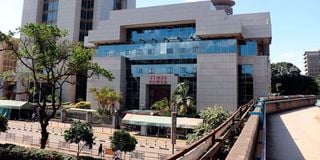World Bank warns automation of KRA systems may limit tax compliance

Times Tower in Nairobi, the headquarters of Kenya Revenue Authority.
The ongoing rapid automation of Kenya Revenue Authority(KRA) systems risks hurting compliance by individuals and businesses by locking out large groups of disadvantaged people such as the visually impaired, those without smartphones, internet connectivity, and limited technological know-how.
The taxman has recently gone big on automated systems including the filing of tax returns and real-time monitoring of sales transactions through electronic invoicing in a bid to maximise revenue collections.
The World Bank, however, cautioned that the shift to automated systems risked secluding sizeable groups of taxpayers with negative consequences on compliance.
“Automation of tax measures will potentially lock out segments of the public including VMGs (vulnerable and marginalised groups) and other disadvantaged groups, due to digital illiteracy, lack of smartphones, poor electricity, and internet connectivity.
Also Read: Tax cheats ditch mobile payments to beat KRA
This will likely lead to non-compliance by individuals and businesses” the multilateral lender said in a note on its backed programme for strengthening governance for enabling service delivery and public investment in Kenya.
Low access to smartphones remains a concern in Kenya even as the government migrated more services to digital. For example, the Central Bank of Kenya put proposals for a digital shilling on the back burner mainly due to low access to smartphones which risked locking out many.
The latest data by the Communications Authority of Kenya for the quarter to June shows that the country has about 30.8 million smartphones—a contrast to the country's overall population of about 50.6 million. It is also important to note that some individuals hold multiple smartphones.
The World Bank urged KRA to enhance tax education and ensure its tax systems accommodated all populations.
“Decentralise stakeholder engagement, and sensitise the public on the tax administration measures, including VMGs and other disadvantaged groups, and implement targeted measures to access those with disability, literacy, and mobility challenges” it recommended.
“Simplify tax education to be understood by all segments of the public and ensure tax systems accommodate all populations such as those with no or limited digital know-how, lack smart-phones, those residing in areas with poor electricity and internet connectivity” it added.
KRA’s new digital system requires trading companies to send real-time data on their daily sales via internet-enabled electronic tax registers
A review of the KRA online and virtual sales control unit shows that traders are required to give detailed information including their business name, physical addresses, and personal identification numbers(PINs) as well as those of the corresponding buyers, the item description, unit price, quantity, total price, and tax designation before any sales transactions would be approved.
The issuance of a buyer’s PIN is however optional on KRA Online & Virtual Sales Control Unit (OSCU & VSCU) -- is a software module that links the Trader Invoicing System(TIS) to KRA for processing of sales receipts.
The KRA system further demands that sales invoices detail the discount percentage offered, the total price of an item with a discount as well as the negative value of the total discounts given as part of a strategy to seal leaks.
A sales invoice will also display the total amount computed before the discount, the total tax-exempted amount, the total amount without tax, the total amount of tax to be paid and the total price to be paid. Further, the invoice will contain the payment method, and the number of items sold and contain a tabular presentation of the various tax components including goods exempted from value-added-tax(VAT), those charged 16 percent VAT, zero-rated goods, non-vatable goods and those charged eight percent VAT.
The invoices will also list the date and time of the transaction, the serial number of the OSCU/VSCU equipment, and a unique signature receipt.





